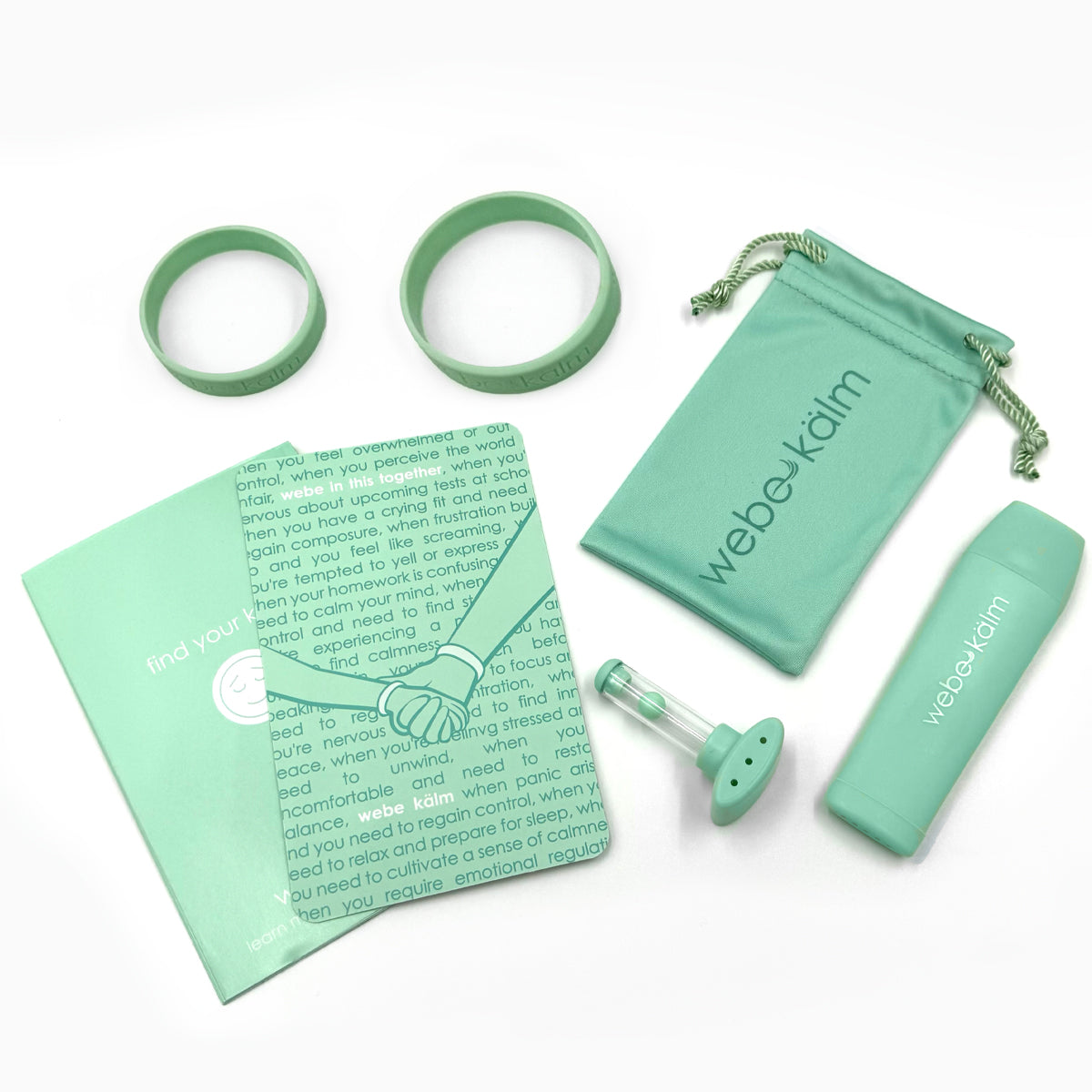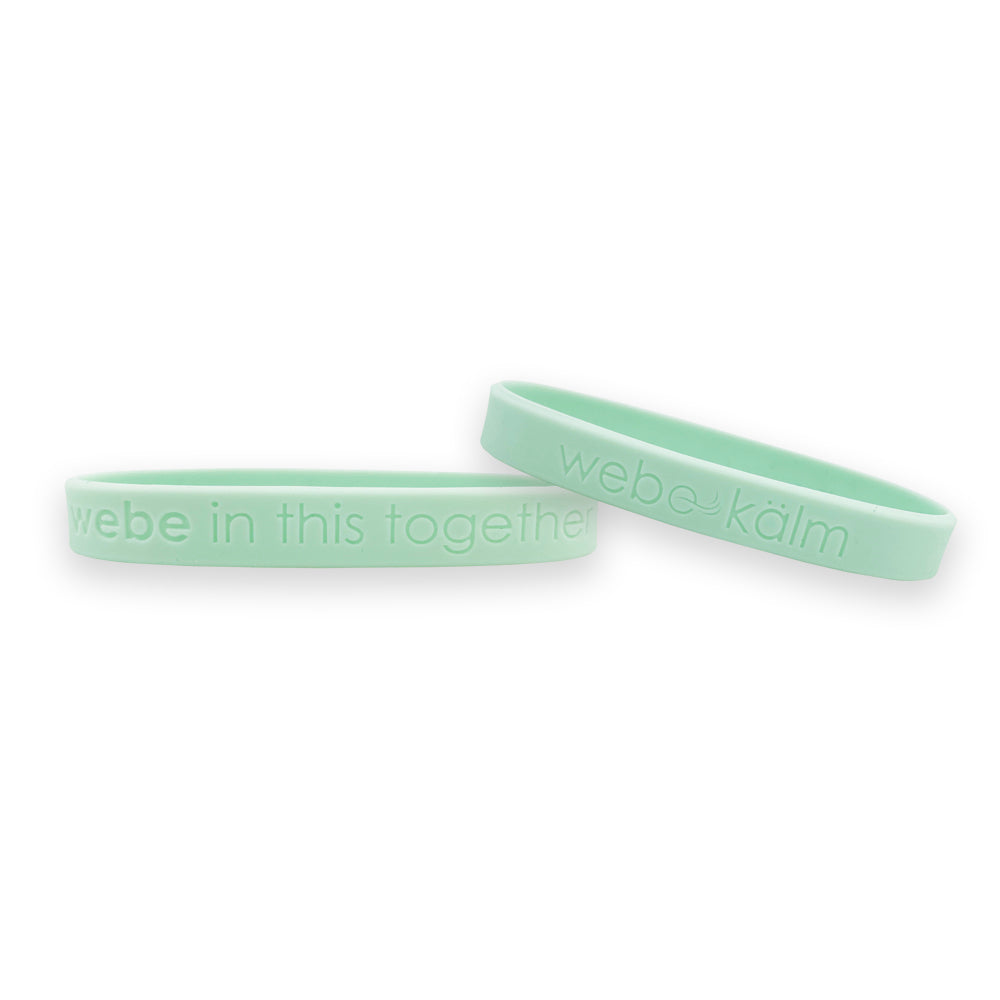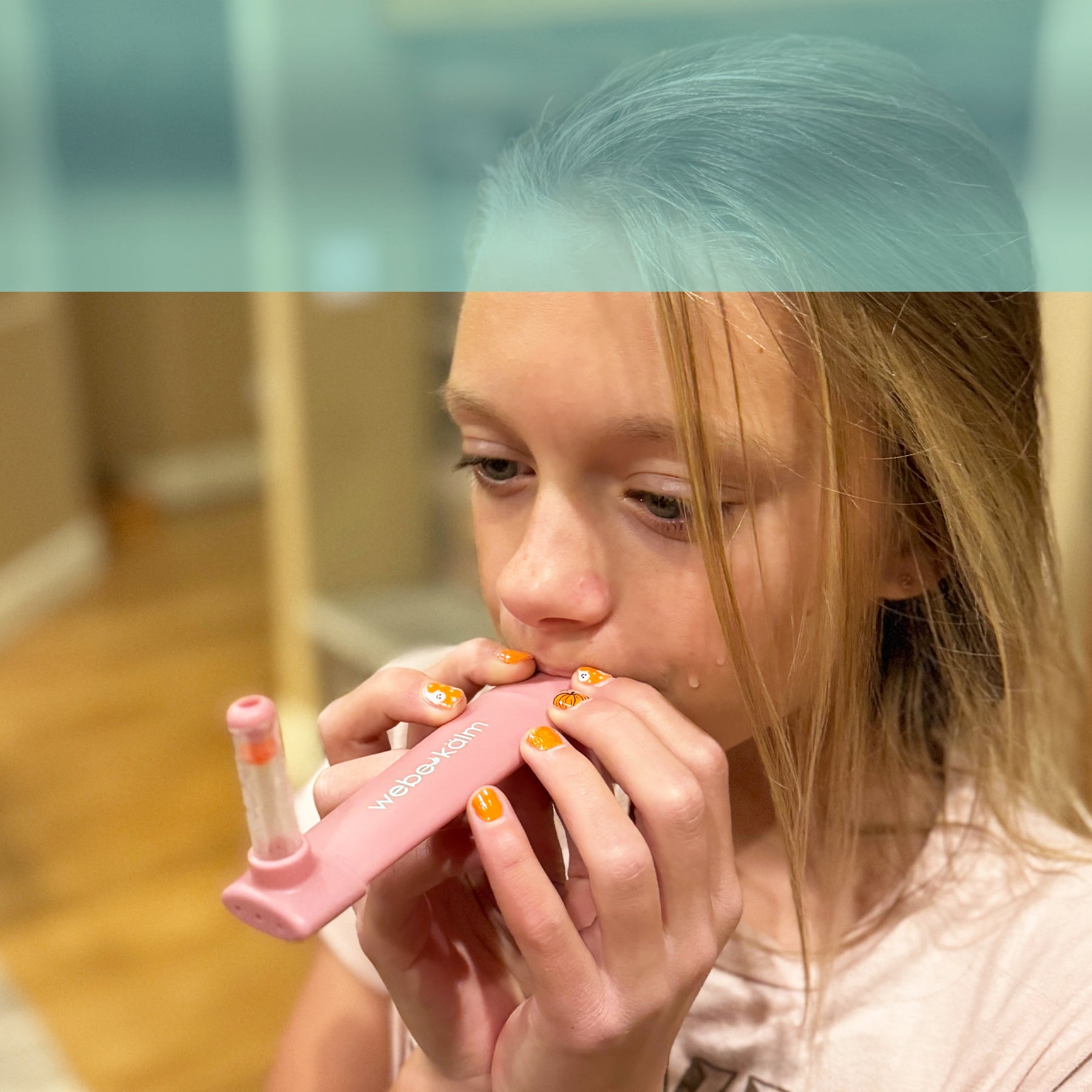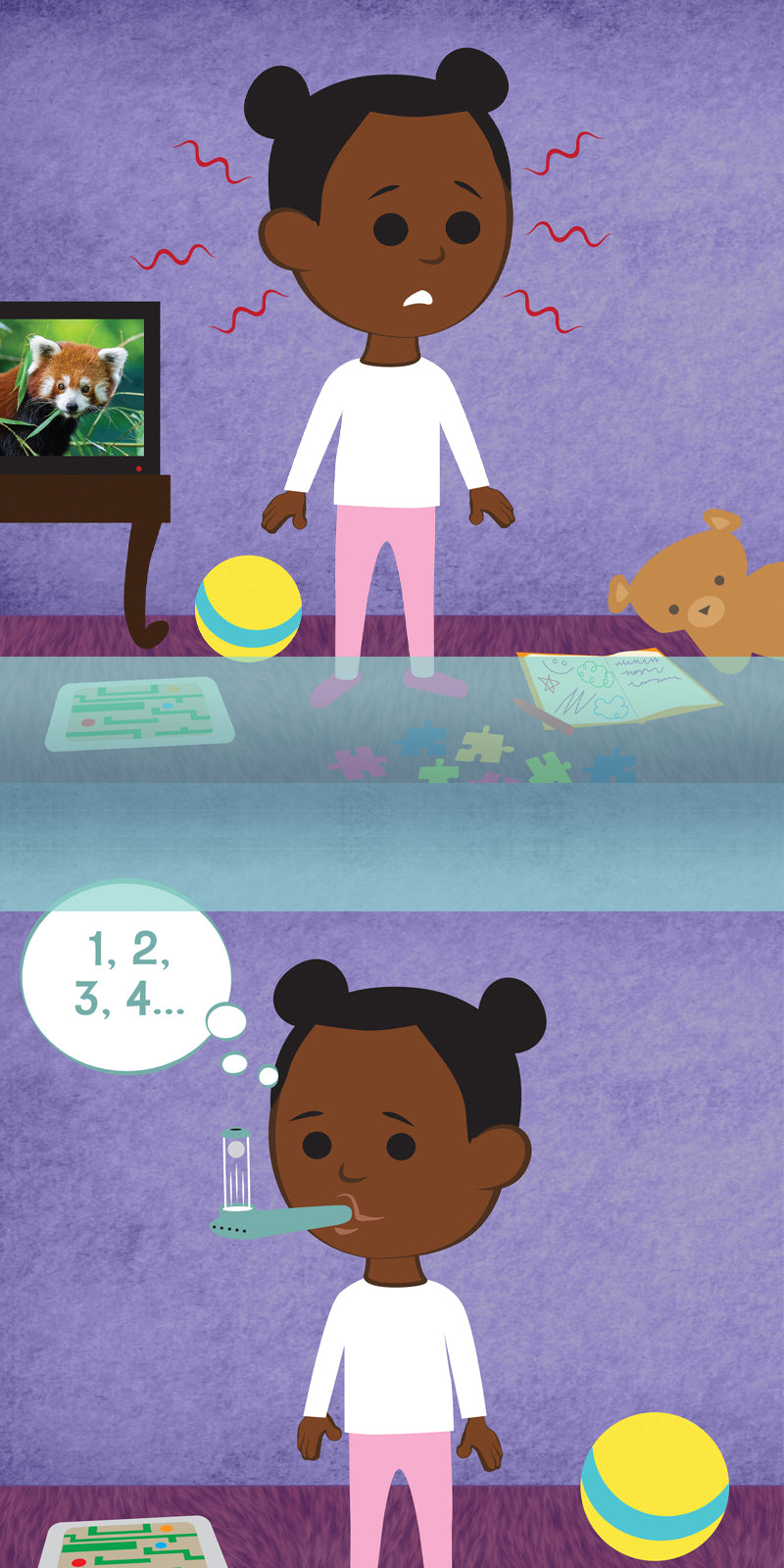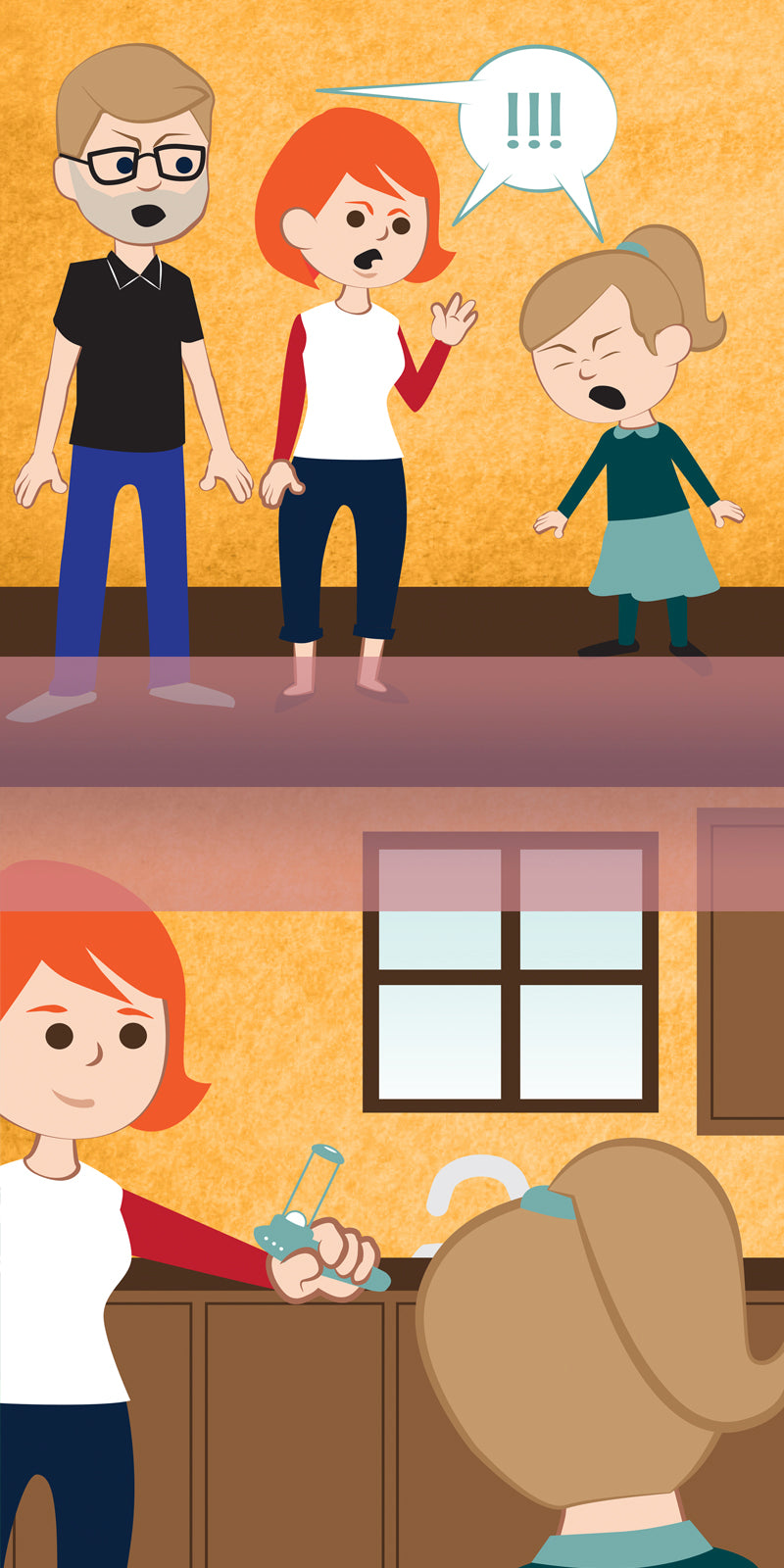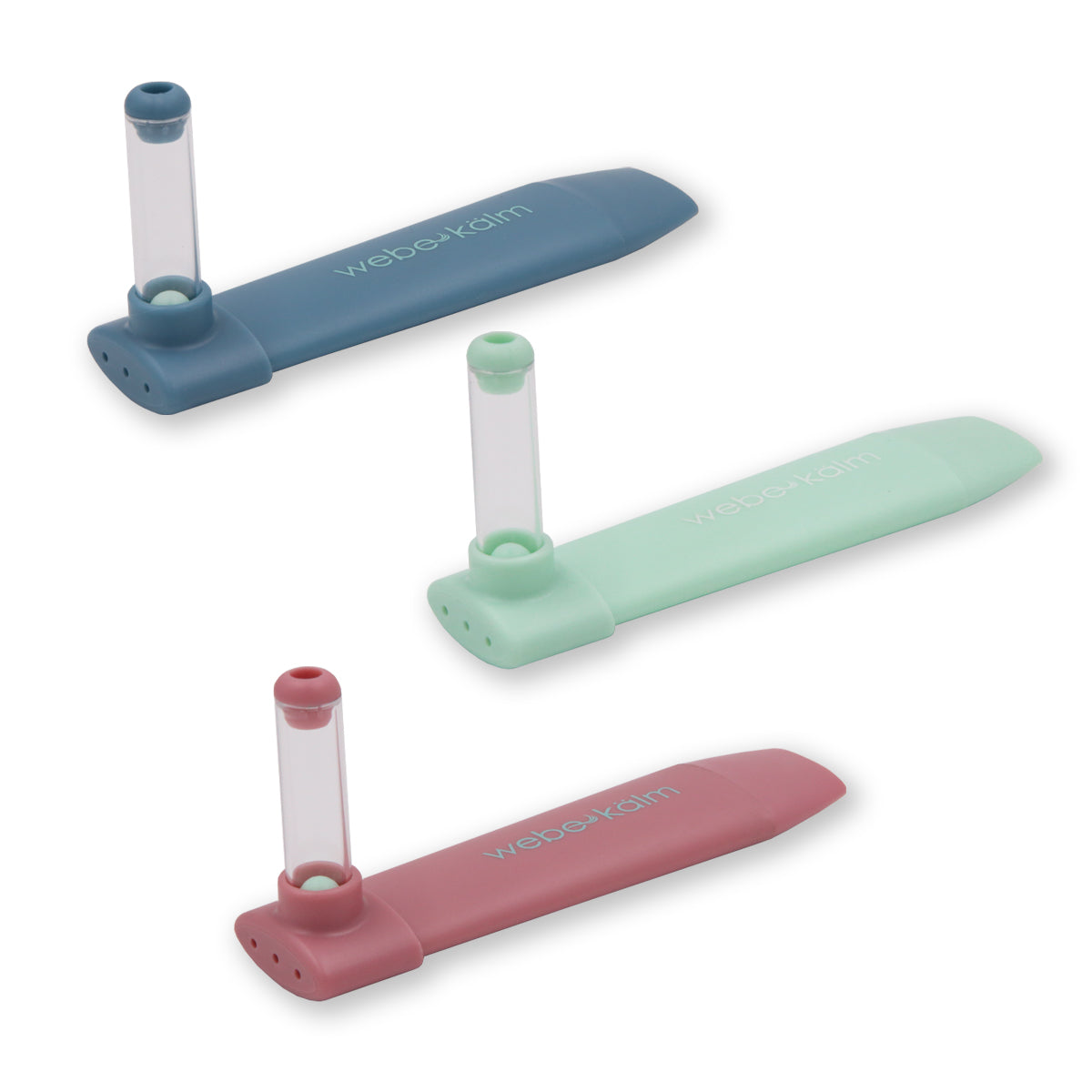what is webe kälm?
a tool that helps adults and children connect during challenging times
find your kälm in less than one minute following these easy steps...
connect
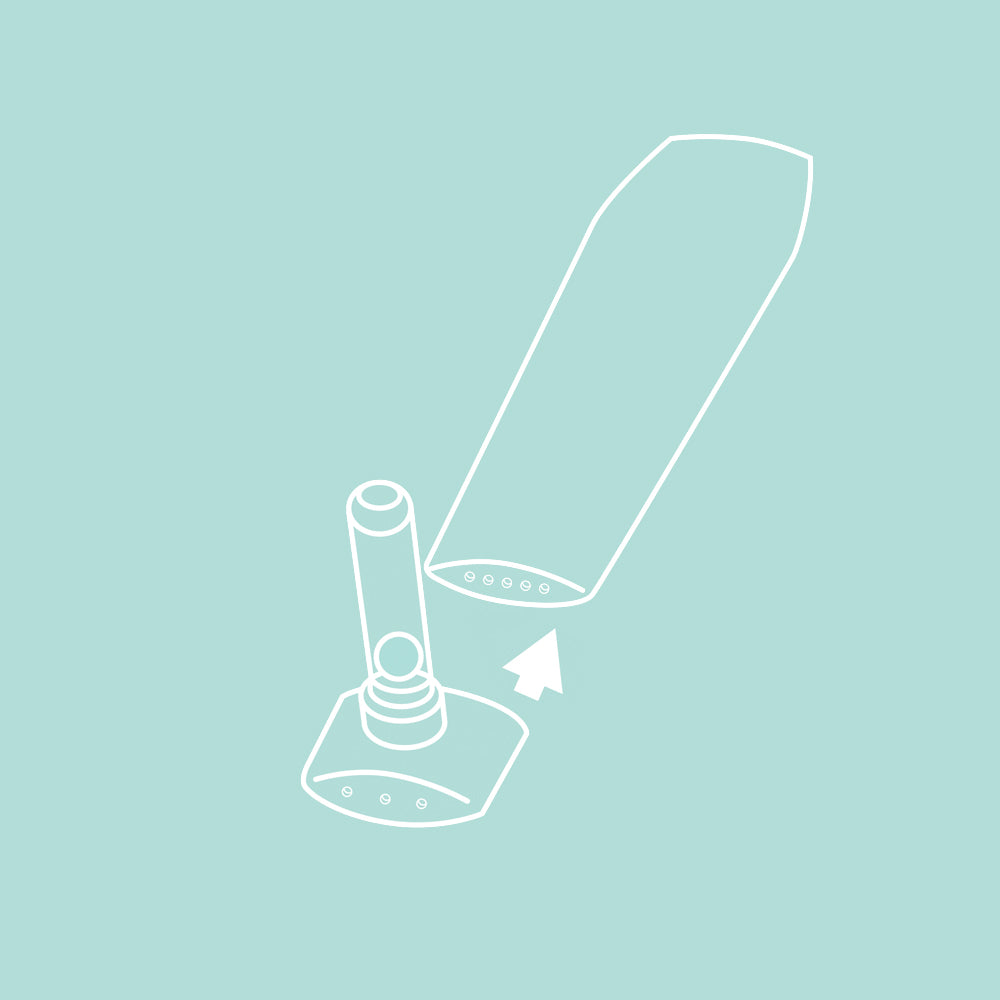
Slide the indicator with the clear tube with ball inside it over the end of the breathe tube until snug.
indicator
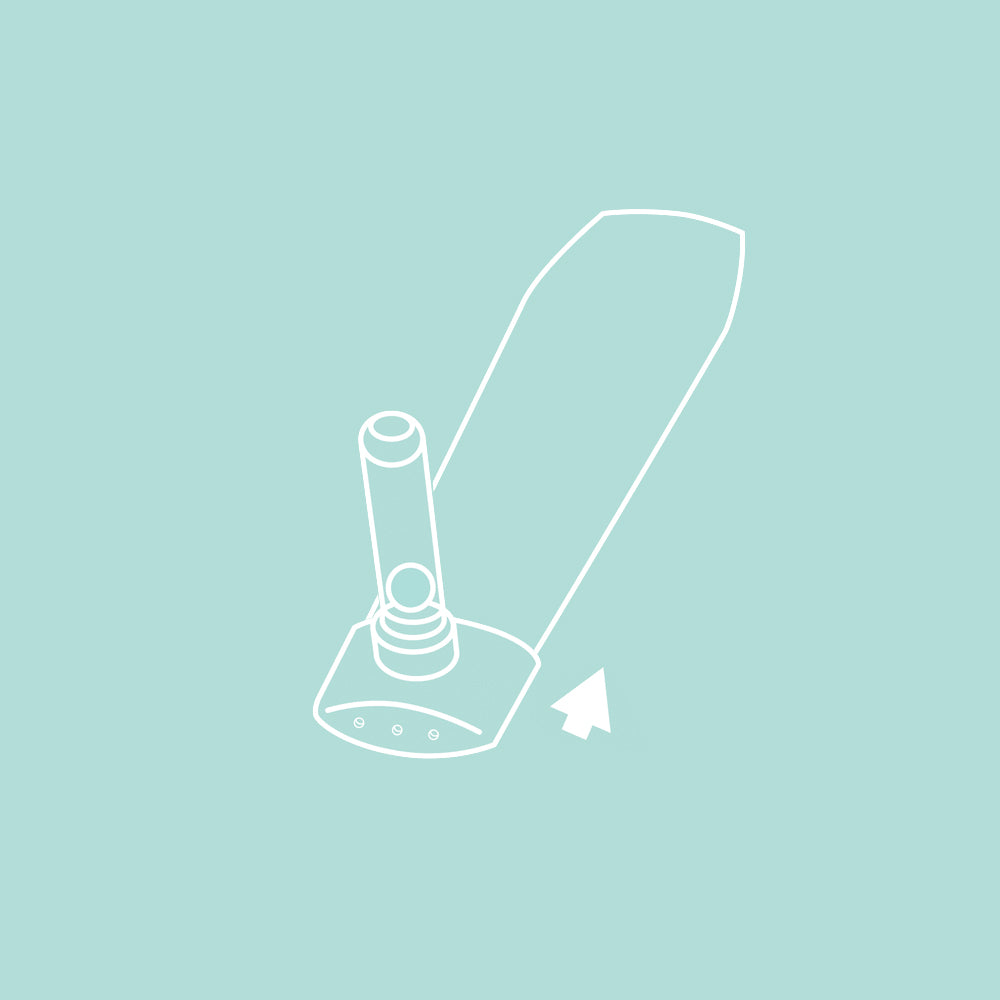
Please note - you do not need to use the indicator for webe kälm to work. When using only the breathe tube, you won't hear the white noise or see the ball lofting, but the slow and extended exhalation still activates the first pathway, leading to a sense of calmness.
breathe in

Breathe in slowly through the nose. Depending on your child you may need to assist them in remembering to breathe in deeply.
fill the lungs
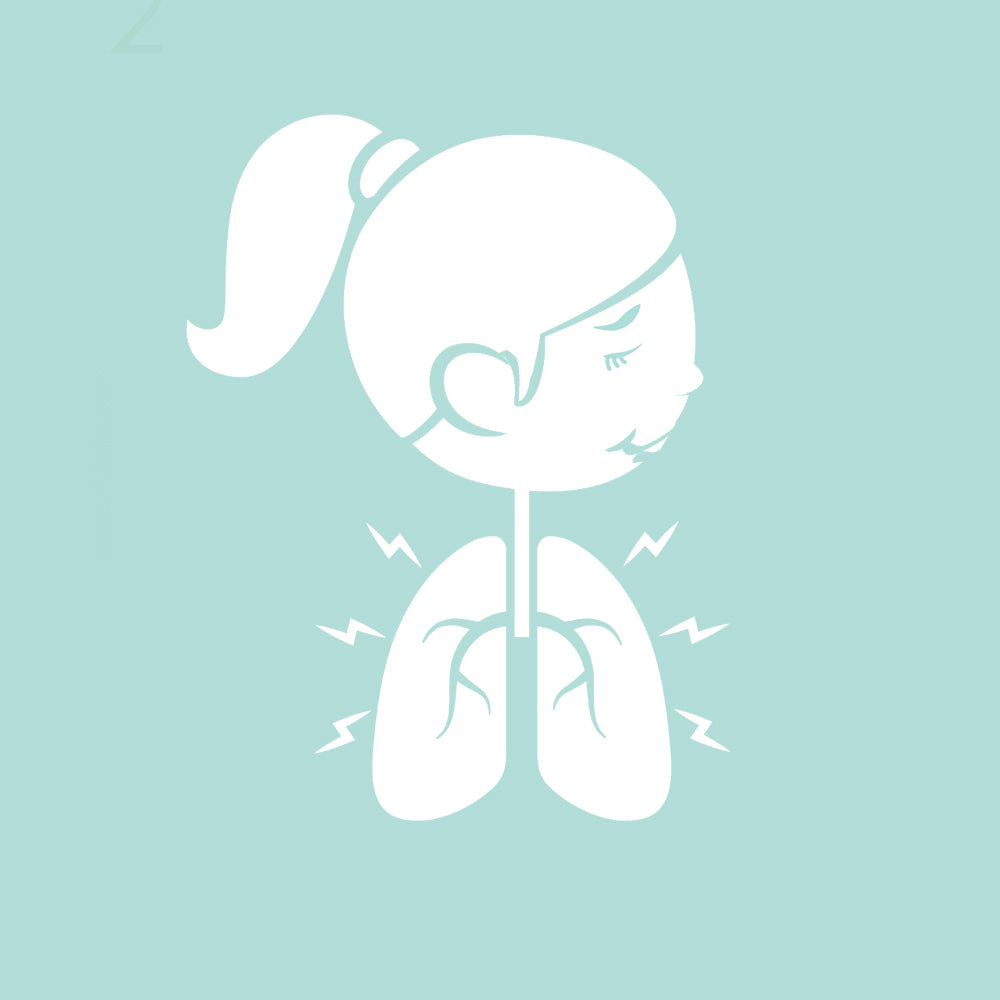
Fill the lungs until they can not take any more air.
exhale
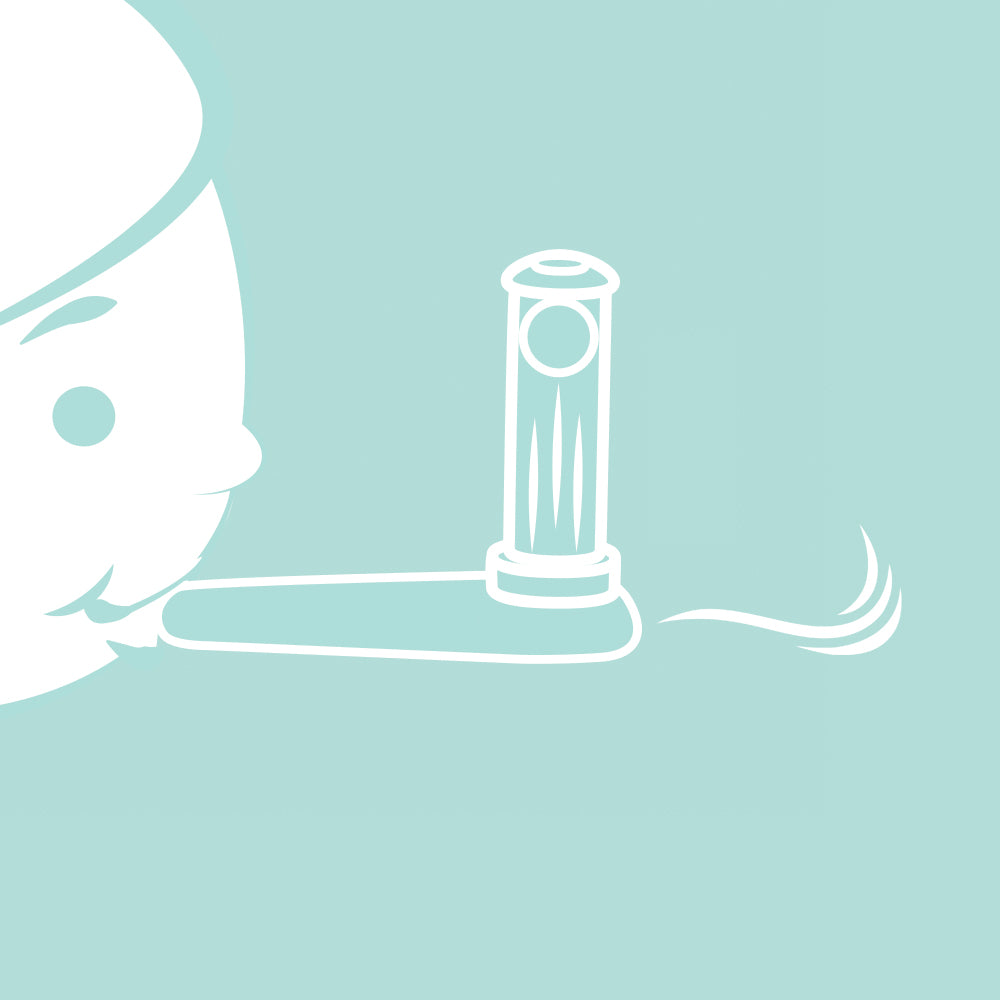
Exhale slowly into the webe kälm mouthpiece to loft the ball to the top of the tube.
slowly
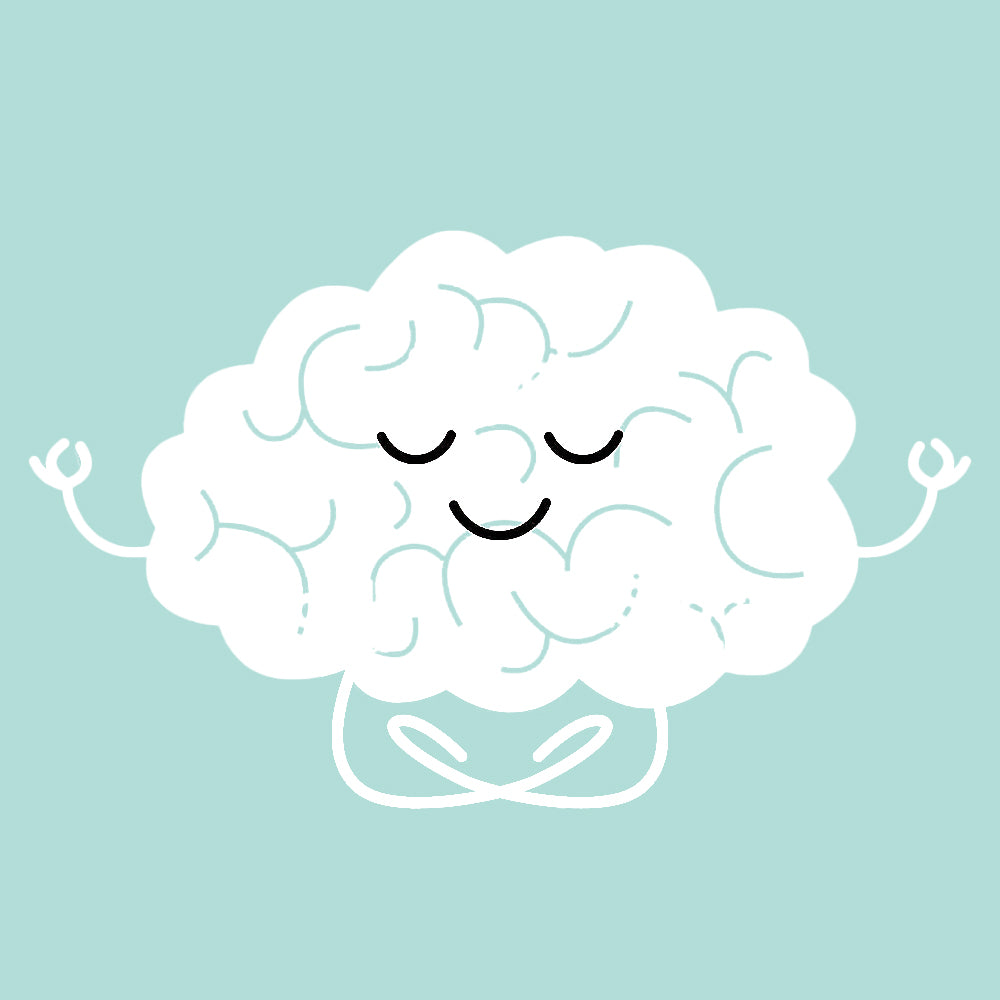
This triggers the first pathway to activating the parasympathetic nervous system and produces a calm state of mind.
visual focus
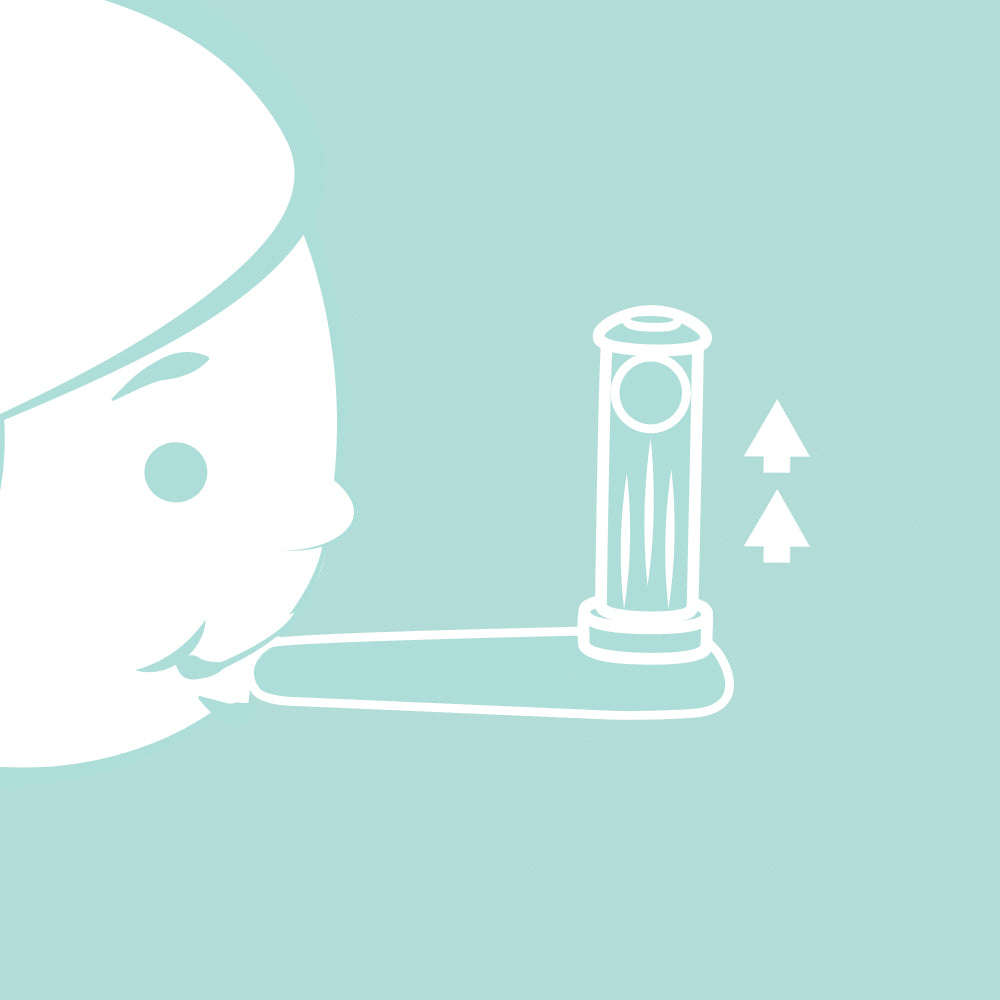
Keep the ball aloft by exhaling slowly through the breathe tube. Visual focus on keeping the ball aloft generates mindfulness.
hold the ball aloft
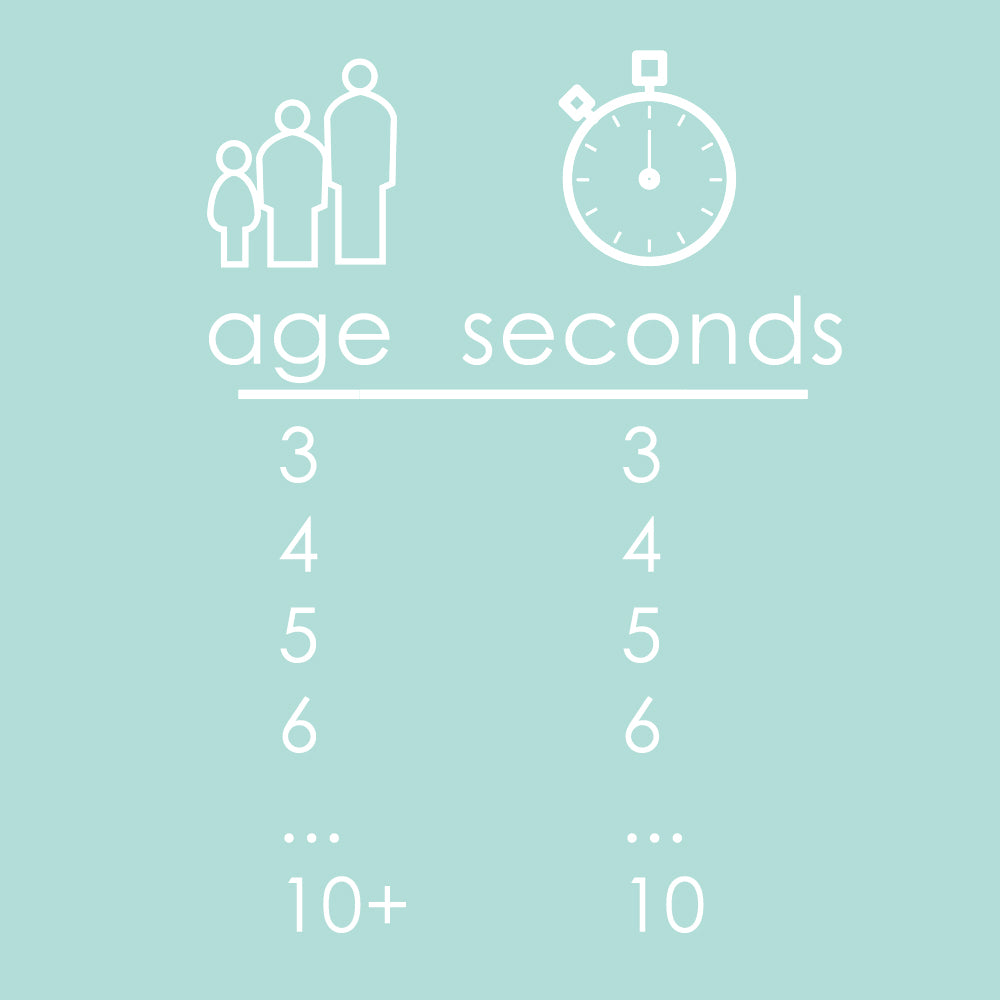
The objective is to keep the ball aloft for the same number of seconds as your age, up until you surpass the age of ten. For instance, a 7-year-old would aim to keep the ball aloft for 7 seconds, while a 10-year-old would strive for 10 seconds. Similarly, individuals aged 10 and above should aim for a 10-second duration.
hear white noise
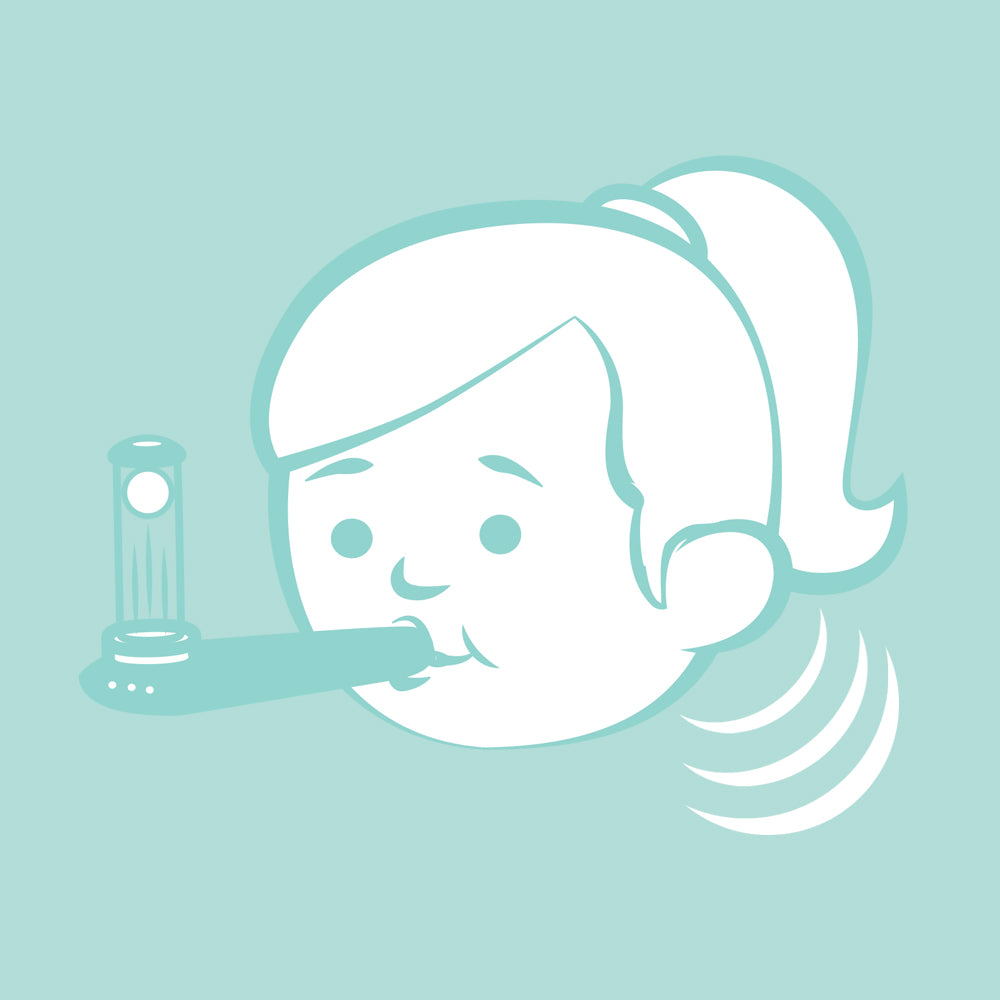
With each exhalation, "white noise" is created in the chamber.
white noise

White noise is reminiscent of natural sounds that trigger neural connections created during fetal development.
repeat 5x
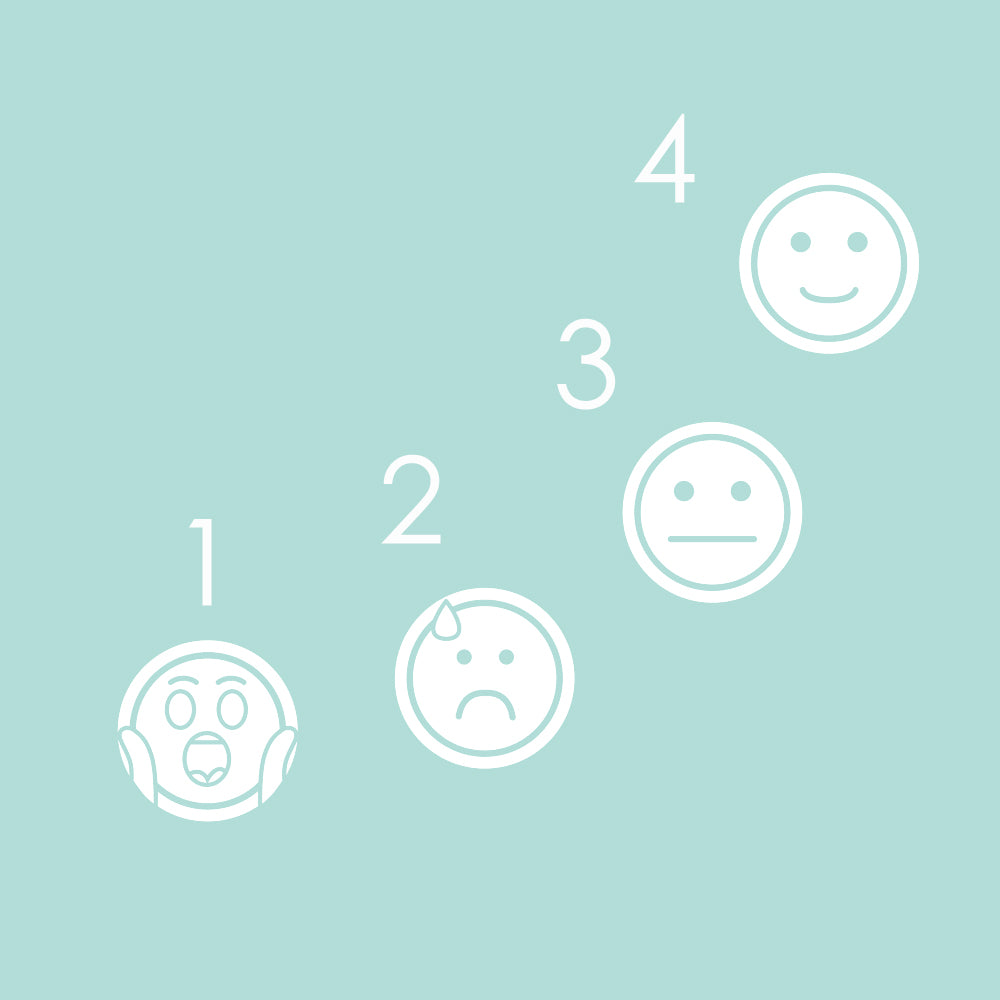
Repeat for the prescribed duration 5 times in a row.
5 = kälm

As the body's system is regulated, watch you child kälm. Use as needed.
1
2
3
4
5
6
7
8
9
10
connect

Slide the indicator with the clear tube with ball inside it over the end of the breathe tube until snug.
indicator

Please note - you do not need to use the indicator for webe kälm to work. When using only the breathe tube, you won't hear the white noise or see the ball lofting, but the slow and extended exhalation still activates the first pathway, leading to a sense of calmness.
breathe in

Breathe in slowly through the nose. Depending on your child you may need to assist them in remembering to breathe in deeply.
fill the lungs

Fill the lungs until they can not take any more air.
exhale

Exhale slowly into the webe kälm mouthpiece to loft the ball to the top of the tube.
slowly

This triggers the first pathway to activating the parasympathetic nervous system and produces a calm state of mind.
visual focus

Keep the ball aloft by exhaling slowly through the breathe tube. Visual focus on keeping the ball aloft generates mindfulness.
hold the ball aloft

The objective is to keep the ball aloft for the same number of seconds as your age, up until you surpass the age of ten. For instance, a 7-year-old would aim to keep the ball aloft for 7 seconds, while a 10-year-old would strive for 10 seconds. Similarly, individuals aged 10 and above should aim for a 10-second duration.
hear white noise

With each exhalation, "white noise" is created in the chamber.
white noise

White noise is reminiscent of natural sounds that trigger neural connections created during fetal development.
repeat 5x

Repeat for the prescribed duration 5 times in a row.
5 = kälm

As the body's system is regulated, watch you child kälm. Use as needed.
1
2
3
4
5
6
7
8
9
10
Why does webe kälm work?
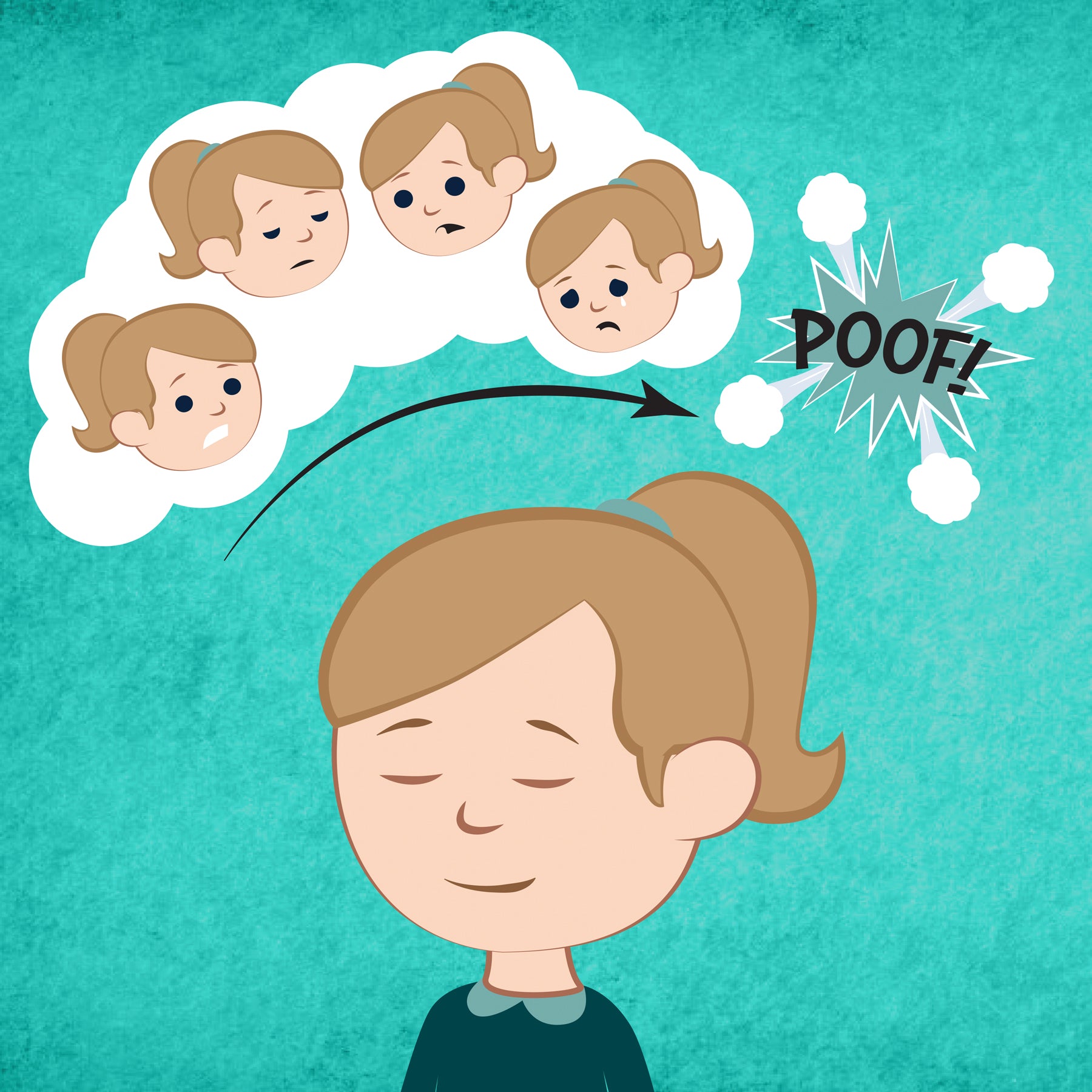
understanding the parasympathetic nervous system
Imagine your body as a car with different modes. The parasympathetic nervous system is the "slow down and relax" mode. When you're active and playing, it's in the "go fast" mode (the sympathetic nervous system). But when it's time to rest, sleep, or eat, it switches to "slow down and relax."
In this mode, your heart beats slower, your body helps with digestion, and it's similar to a cozy nap for your insides. It's the part that helps you feel calm and balanced after being busy or a little scared. So, the parasympathetic nervous system is the relaxing mode for your body, ensuring you feel good and balanced inside.
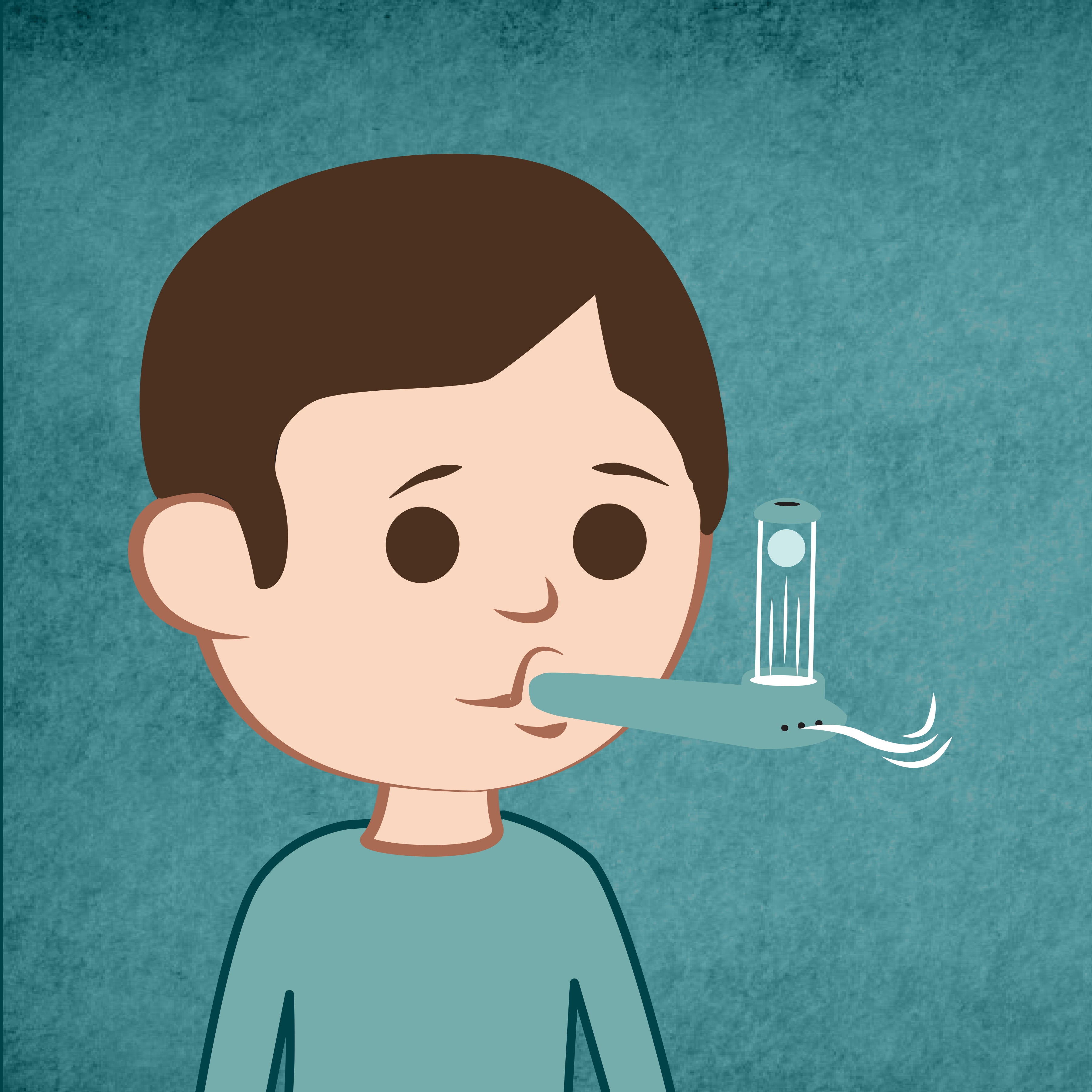
slow extended exhalation
Breathing slowly and exhaling through the mouthpiece has an immediate calming effect. Studies have shown that this technique enhances flexibility in the autonomic, cerebral, and psychological aspects of our body.
It's linked to parasympathetic activity, which helps control emotions and overall well-being. This technique increases Heart Rate Variability and Respiratory Sinus Arrhythmia, with changes in Central Nervous System activity. EEG studies show increased alpha power and reduced theta power. Additionally, MRI studies reveal increased activity in various brain structures, leading to increased comfort, relaxation, pleasantness, vigor, and alertness, while reducing symptoms of anxiety, depression, anger, and confusion.
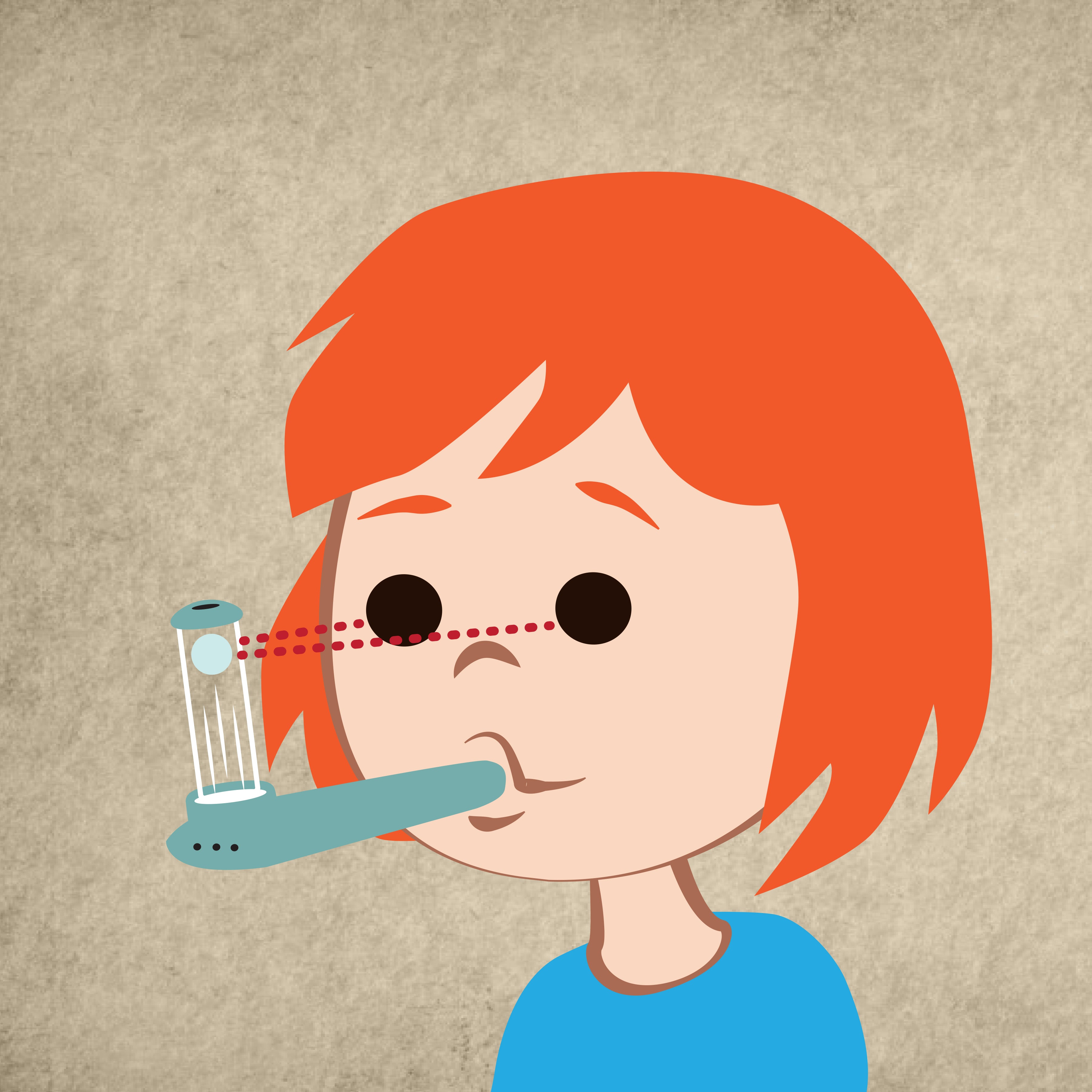
visual focus
When we practice focused attention with webe kälm, it helps us stay calm when things get tough and makes us better at handling problems.
Imagine it like playing a game where you keep a ball in the air. This game helps our minds stay focused and not get too upset. Scientists found that when we play this game, our brains work better. The part of our brain that helps us control our feelings gets stronger, and the part that makes us feel really upset gets quieter. This helps train our brains to be strong and calm, which helps us when we face things that make us feel unhappy.
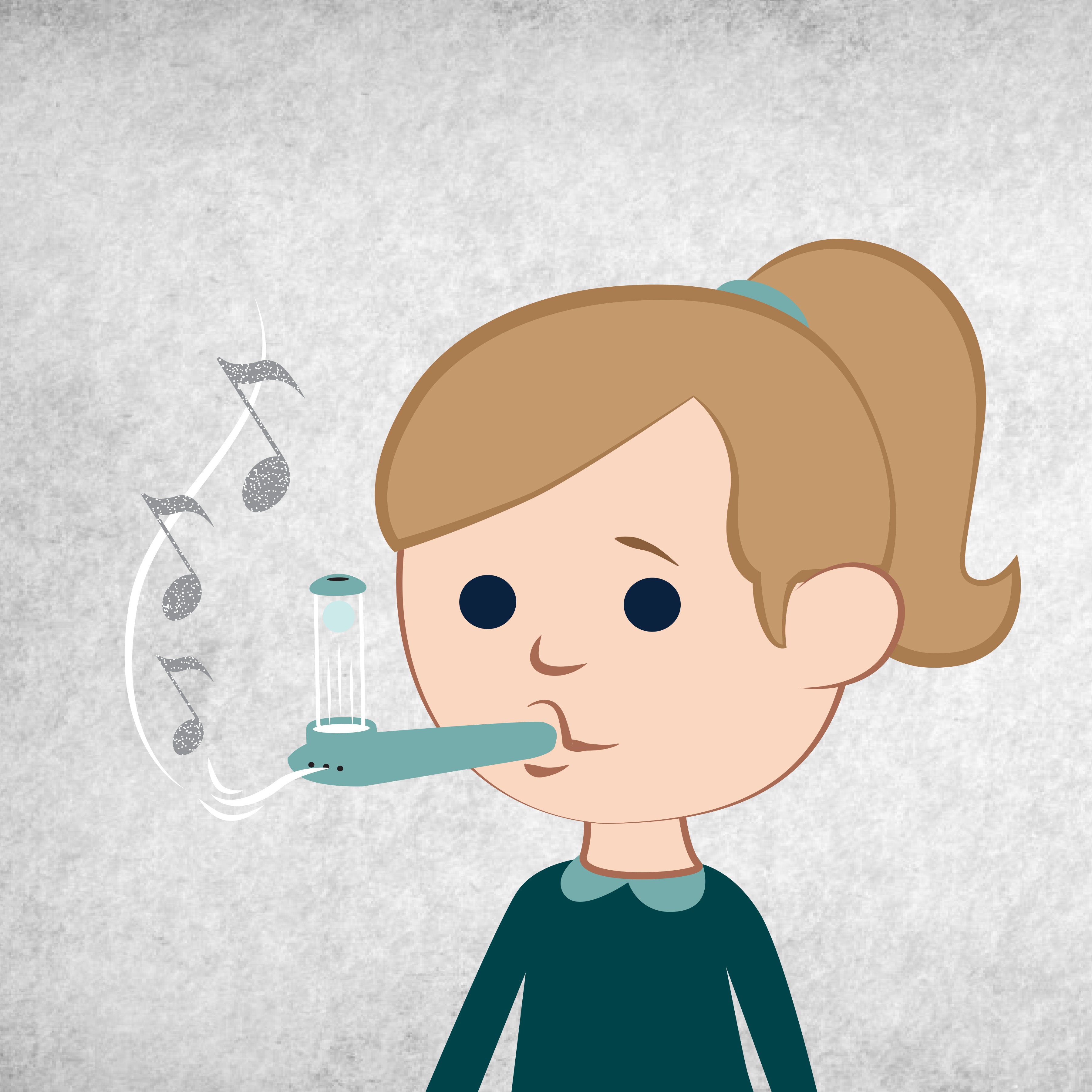
auditory regulation
When you use webe kälm and breathe out, it makes a soothing, calming sound we call "white noise." It's similar to the gentle sounds babies hear when they're in their mommies' tummies.
These familiar sounds can help kids feel relaxed and sleep better. It's like having a friend that helps you feel calm and sleep well.
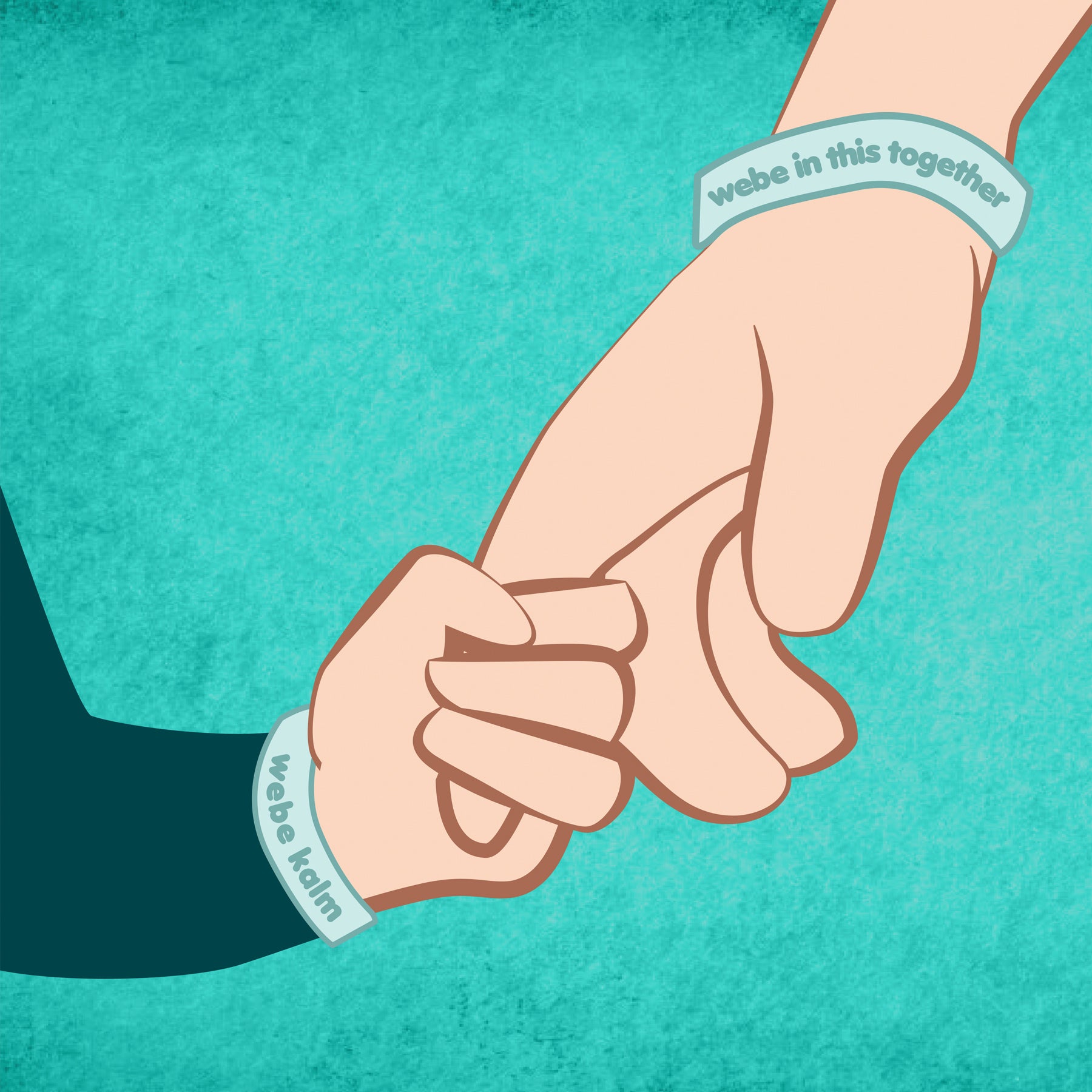
co-regulation
Fostering a collective sense of calmness within our community is the ultimate objective. It's vital for adults to actively participate in assisting children, rather than simply substituting "calm down" with "go use your webe!"
- wee (age 3-8): This is particularly important for young children who require guidance and cooperation from adults. It's helpful to let them know that you also need moments of calm and by counting seconds while they use webe kälm creates connection. They appreciate knowing you're invested in the process.
- Tween (age 9-12): There's often a snarky response when asked to calm down, "I am calm!" It no longer needs to be a contentious battle of "you vs. them" to determine calmness. webe kälm provides feedback to help tweens gauge their state of calm. If they are calm, they can exhale slowly and keep the ball aloft. If they're not, the feedback can help prevent a tense situation from escalating into an argument.
- teen (age 13+): In the teenage years, where self-awareness is burgeoning, webe kälm offers feedback to determine if they are balanced and calm or if they need to regain balance. They can use webe kälm with or without the indicator discreetly during moments when they prefer not to draw attention.
from unbalanced to calm
We believe that everyone should have the opportunity to experience the benefits of kälm. If you're finding that webe kälm isn't producing the desired results using your current approach, we encourage you to explore our social media channels to discover what other parents have found effective.
It's important to understand that webe kälm shouldn't be used as a quick fix like a pacifier to instantly soothe a child. Instead, parents should take an active coaching role, guiding their children through the breathing process to help them learn how to use it. Over time, children will develop the skills to self-soothe, eventually reducing their reliance on webe kälm. Remember, learning to soothe oneself is a gradual process, much like how we first learn to crawl, then walk, and eventually run.
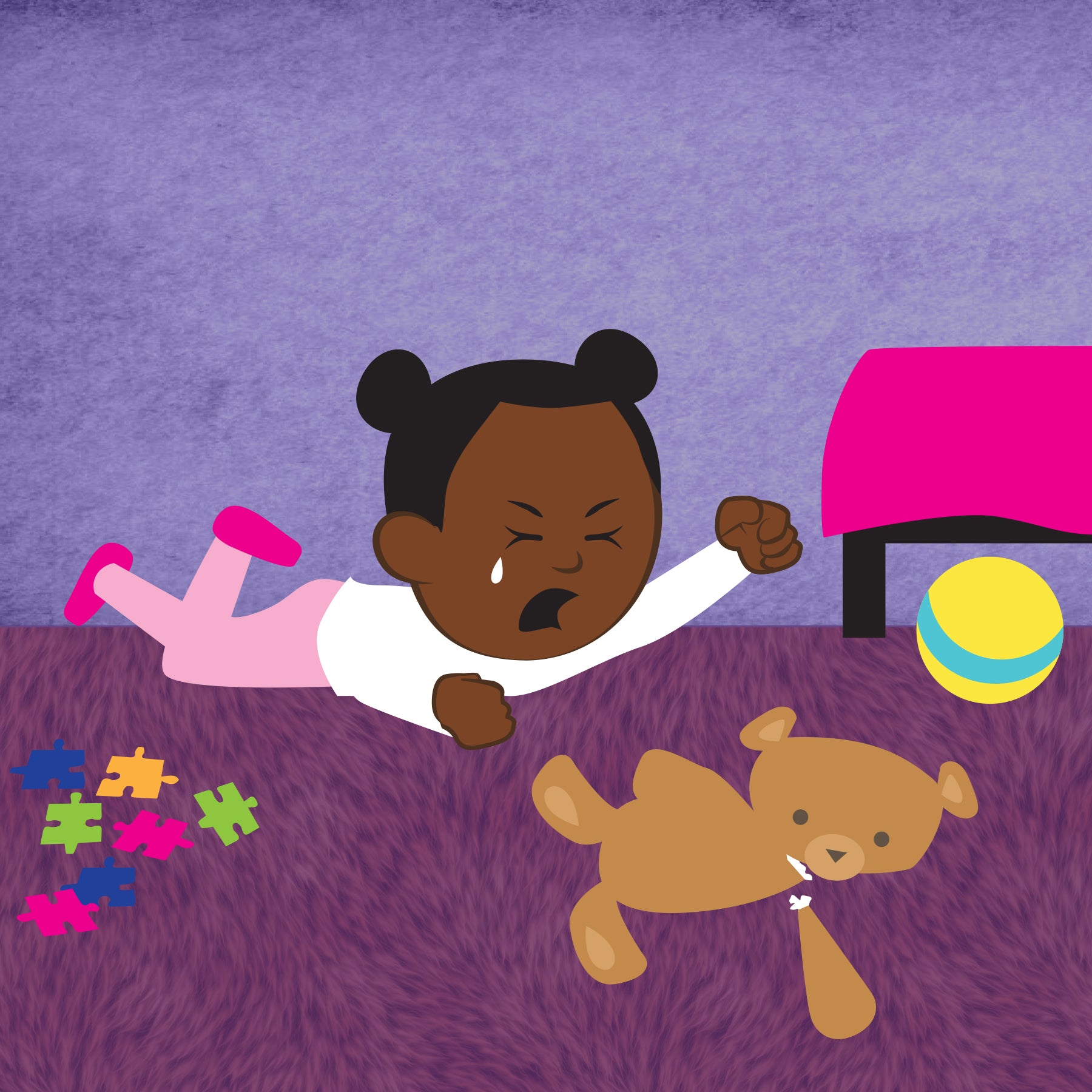
unbalanced
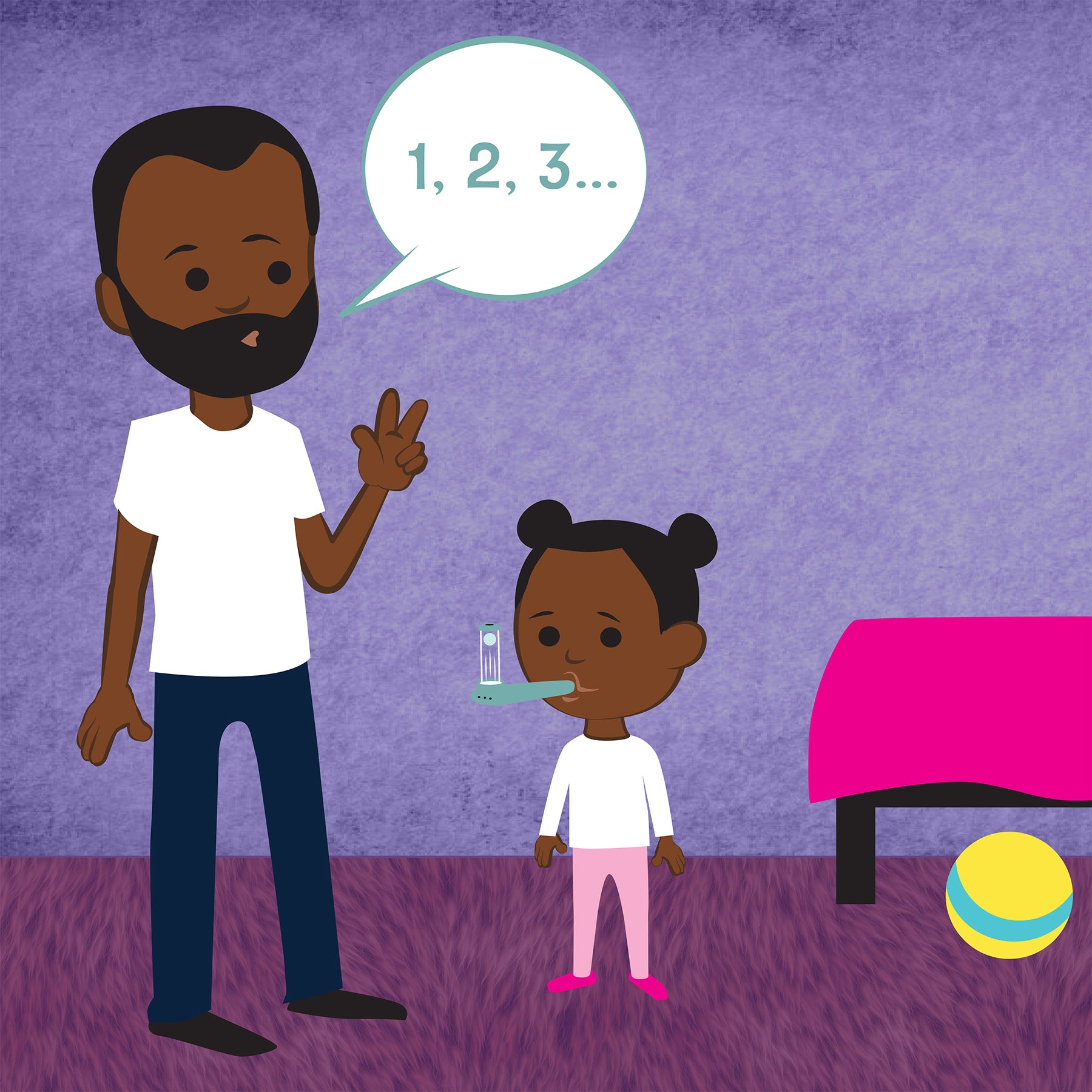
calm
Want help understanding the science behind webe kälm?
Take the deep dive into understanding the science behind webe kälm.


